Thanks for your support! If you make a purchase using our links in this article, we may make a commission. And, as an Amazon Associate, I earn from qualifying purchases. See the full disclosure here.
Updated April 13, 2024
A generator for a 30-amp RV is essential since power is not always a given. Besides, if you enjoy boondocking or going off-grid here and there, a generator for your 30-amp RV will be your primary source of energy.
Unfortunately, the ins and outs of generator sizes for 30-amp RVs tend to get confusing at times. This is especially true when it’s your first time with an RV. When you look into the many different ways of RV power generation, like solar panels, and even the potential of portable wind turbines, you’ll want to throw up your hands in frustration.
Well, we don’t want you to throw up your hands in frustration. Breaking down the right size generator for your 30-amp RV is not as difficult as it sounds. This article will lay it all out for you in layman’s terms. We’ll cover wattage, levels of power consumption, and the best generators on the market for your RV.
- How Many Watts Does It Take to Run a 30-Amp RV?
- Is 30 Amps and 3,000 Watts The Same Thing?
- Do Any Travel Trailers Come With Generators?
- What Type Of Generator Do I Need For 30 Amp: Inverter or Conventional?
- Can I Run My RV Air Conditioner On 30 Amps?
- What Does Shed Mean on an RV Thermostat?
- 3 Things to Look for in a 30-Amp Generator?
- Is Gas Or Propane Better For A Generator?
- 4 Best Generators for 30-Amp RVs
- Final Thoughts On What Size Generator Is Best For 30-Amp RVs
- Related Reading:
- Mike Scarpignato – Bio
How Many Watts Does It Take to Run a 30-Amp RV?
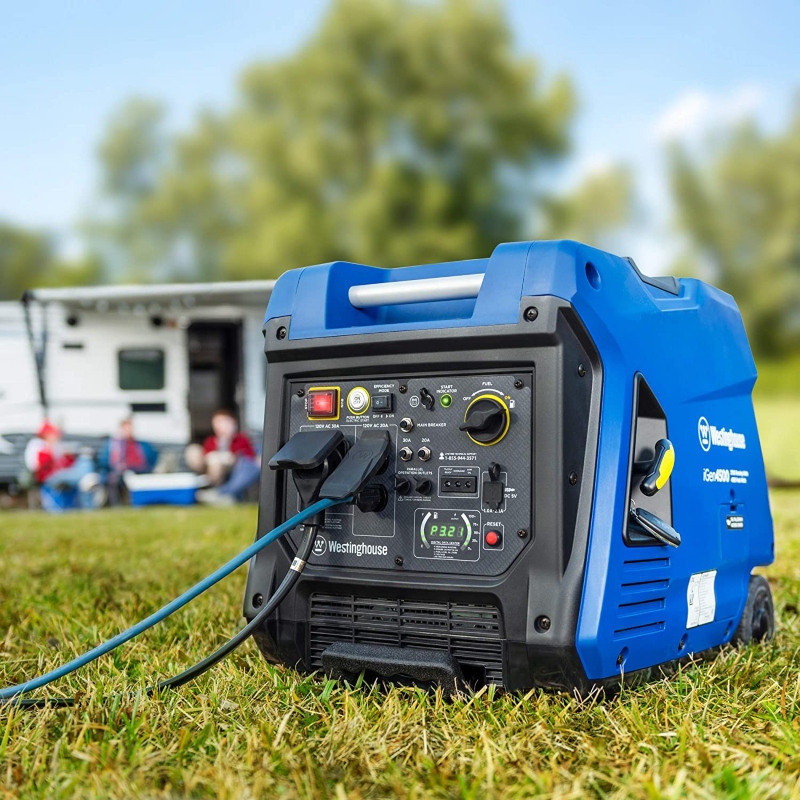
Theoretically, it would take 3,600 watts to run a 30-amp RV if everything is maxed out. Of course, nothing is ever quite so simple. In reality, you’re not going to run everything in your RV at exactly 3,600 watts. A 3,600-watt generator would struggle with that anyway (if it would even run without tripping the breakers).
For what it’s worth, the formula for determining watts is (the number of amps x 120 volts = watts). In this case, 30 amps equals 3,600 watts. There are three terms you should familiarize yourself with—watts, volts, and amps.
How Electricity Works
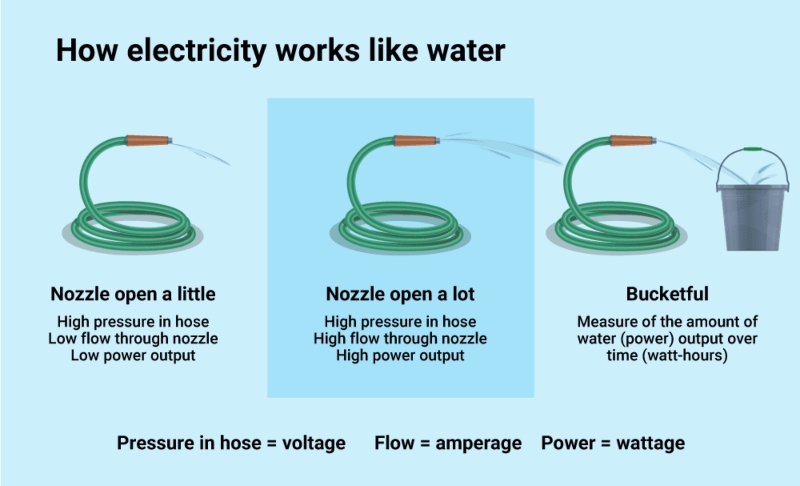
Think of it all as if you’re handling a water hose. The amps represent the size of the water hose. The volts translate into the volume of liquid flowing through the hose. The watts can be thought of as the pool of water (in this case, energy) you have available to run through the hose.
The average RV consumes 20 kWh per day. A 3600 generator is capable of supplying enough power to reach that average or more. Even a 2,000-watt generator will reach 20 kWh in 10 hours.
Is 30 Amps and 3,000 Watts The Same Thing?
A 30A RV is not necessarily the same thing as 3,000 watts. For one, a 30-amp RV is a 120-volt system. To convert amps to watts, you have to multiply the number of amps by 120 volts. In this case, 30 amps multiplied by 120 volts is 3,600 watts of output. So, if you have a 3,000-watt generator, you don’t have 30 amps.
That doesn’t mean you can’t run a 30-amp RV with a 3,000-watt generator. You may have to make concessions and balance everything out. RVers already know that it’s not a good idea to run several, heavy power consumption appliances at the same time. The same rule applies here, only with additional moderation.
Running too many appliances will overload your generator. Attempting to run the A/C at the same time as the microwave will likely not be possible.
Do Any Travel Trailers Come With Generators?
Some travel trailers come with built-in generators, but the vast majority do not. If you’re into outdoor adventuring and want to take your RV out into the wilds and experience a little adventure, a generator is a must.
If you purchase a generator, make sure that it’s rated for RVs and it’s at least 3,600 watts. A 3,600-watt generator will run a 30-amp RV without a hitch, at least until it runs out of fuel. Fortunately, if you find a travel trailer that comes with a built-in generator, you won’t have to worry about matching everything.
What Type Of Generator Do I Need For 30 Amp: Inverter or Conventional?
A conventional generator will definitely do the job. However, the type of generator you need for a 30-amp RV should be an inverter generator. You’ll spend a little more in the short run, but the benefits are too numerous to wave off.
- Inverter generators are fuel-efficient
- They are much quieter than conventional generators
- These generators have automatic controls for fuel savings
- Produces more alternate current (AC) per engine rotation
- The current created is more stable than it is in a conventional generator
- Converts AC to DC power and “inverts” DC back to AC electricity
This inversion process does a number of things. First, it generates stable electricity (a smoother current without peaks and drops). Second, this improves fuel efficiency, along with the automated throttle controls. Third, the automation and inversion process is safer and keeps your electronic devices safer as a side effect.
If there is one thing that sells consumers on generators, it is fuel efficiency. Living in an RV places limitations on your weight and mobility. Onboard, installed inverter generators require less fuel and maintenance.
Inverter generators, if you don’t have one installed, are also more portable and lightweight than their conventional generator cousins. An inverter generator’s compact and lightweight nature is always a bonus.
Can I Run My RV Air Conditioner On 30 Amps?
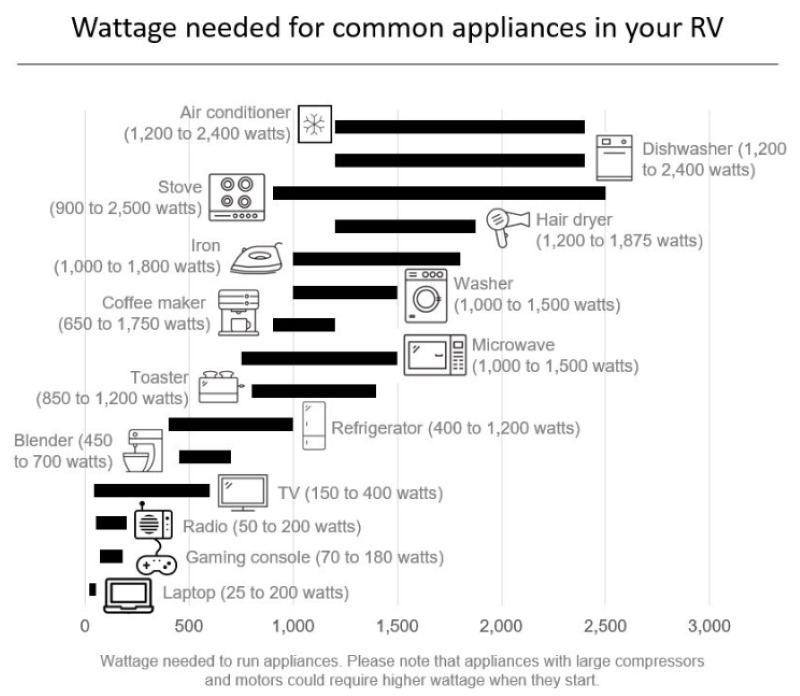
An RV air conditioner shouldn’t have any problems running on 30 amps. It’s when you combine all of the appliances in your RV that you have to worry. You also have to consider “surge” amps versus “running” amps.
- 15k BTU A/C – 1500 watts/13 amps
- 6-gallon water heater – 1400 watts/12 amps (LP mode negates this – 12v power is used instead)
- Space heater – 1500 watts/13 amps
- Hair dryer – 800 to 1500 watts/7 to 13 amps
- Coffee pot – 1300 watts/11 amps
- Induction stovetop – 1200 to 1800 watts/10.5 to 13 amps
- Convection microwave – 1450 watts/12.5 amps
- Battery charger: 1700 watts/15 amps
Now, keep in mind that the above list isn’t exact, and amps are different with different devices, smaller or larger. But it’s a decent enough guide to give you an idea of what you are looking at. Let’s say it gets really warm in the RV as the sun is coming up in the morning.
The generator is running, and you just turned on the coffee pot. You are also cooking breakfast on the electric stove. Using the above-listed low-end induction stovetop at 10.5 amps, the just-started coffee pot is currently drawing 11 amps. You also have the above-listed A/C unit, but you’re already using 21.5 amps before you even turn on the A/C unit.
Until the coffee pot drops down into the lower wattage for heat maintenance, kicking on the A/C will trip the breaker because 10.5 + 11 = 21.5 amps. Then when the A/C turns on you are adding an additional 13 amps for a total of 34.5 amps. This example is very simple and does not factor in the amps the A/C draws when it first starts up. We cover that in the next section.
Of course, some appliances in an RV are different, such as running on propane or the energy stored in the house batteries. That’s not the point. The point is simply to show how quickly and easily you can overwhelm the generator.
What Is A Soft-Start Device For An RV Air Conditioner?
Let’s say the average RV air conditioner runs steadily at 13 amps. It actually requires more than 13 amps to cycle up. It could take as much as 26 amps to get started and fire up the compressor. If you’re plugged into a 15-amp or 20-amp power supply, the A/C could trip the breaker. When you turn it on the initial burst of energy needed to start the A/C is more than the 15 or 20-amp circuit can handle, and the breaker will trip.
Some RVers have a unique way of getting around this. By installing a soft-start device this initial burst of energy is eliminated. Many of the bigger RV manufacturers have added these devices to their 30-amp travel trailers and motorhomes in the past 2-3 years.
What this means is they start the fan only, then move to the lowest setting, then go higher from there. It takes time, and a soft-start device automates the process but keeps the A/C from using a high amount of amperage to start.
However, if your RV doesn’t have a soft-start device for the A/C, you’ll have to plan for the large amount of amperage that’s used every time it starts up. Plus, it’s a good idea to calculate what you’ll be using while the A/C is running.
To make the calculation a little easier just remember that all 12v devices run on 12.5 amps. So, if you have any 12v appliances onboard, you should automatically know what it takes to run them.
What Does Shed Mean on an RV Thermostat?
“Shed” on an RV thermostat means what it sounds like. The “shed” function is nothing more than shedding the compressor (turning it off) when the A/C unit runs too long or the power draw is inadequate to keep the compressor working overtime.
With two A/C units, the shed function is the same, except it might only turn off the compressor in one of the A/C units while maintaining the other one. It’s basically an automation that balances everything out by reacting to a lack of current or overworked compressors.
The shed function is also a power-saving function. If your 30-amp RV has two A/C units and the units are ducted together through the ceiling, the A/C that has the compressor on will send the cold air through the ducting. The other A/C unit will keep its fan on to draw the cold air toward the end of the RV.
Both A/C units will alternate the shed function every few hours so one end of the RV doesn’t become colder than the other.
3 Things to Look for in a 30-Amp Generator?
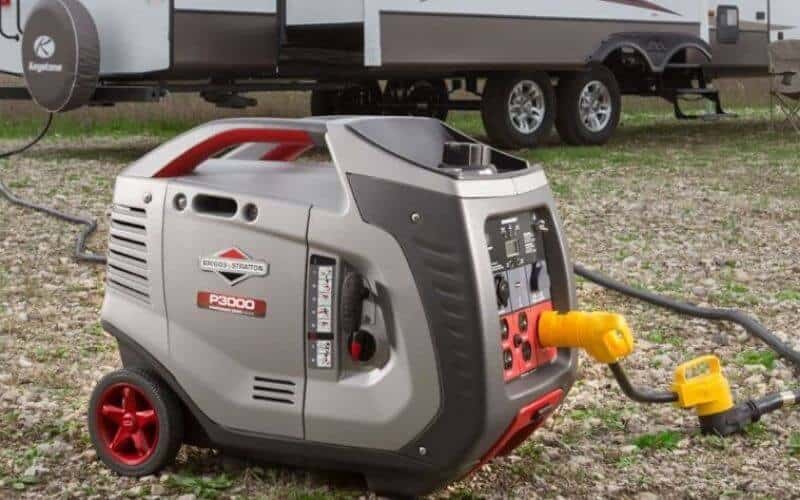
When it comes to watts, a 30-amp generator is maxed out at 3,600-watt. If you find a generator that’s higher than 3,600 watts, you’re not looking at a 30-amp generator. The lowest you want to go is 2,000 watts, but it all boils down to your power needs. How well you manage power and what you want should be your deciding factors.
If you want the absolute maximum in your RV, go with a 3,600-watt or much higher. You can run a 30-amp RV on a massive generator if you want. You can even parallel two generators.
Many generator manufacturers offer parallel cables with a central device that allows you to draw from both generators. If you have a 30-amp RV and want to maximize your power consumption in the RV, this setup may be what’s best for you.
1. Noise Level
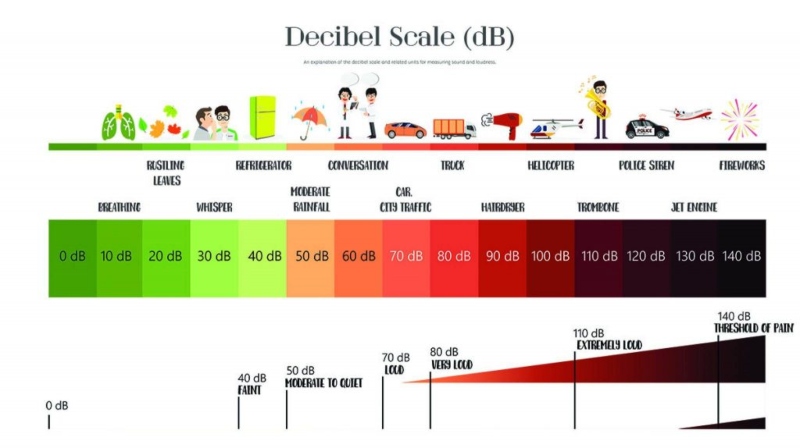
If you’re way out in the boonies, going off-grid, and you sleep with a box fan, noise may not bother you too much. It will even have the added effect of scaring off unwanted wildlife. You will have to be concerned with the noise level your generator for your 30-amp RV makes if there are nearby campers and RVers. Maintaining “Campground Etiquette” is a thing, after all.
Decibel levels on the generator you are thinking of choosing will be listed on the box label or should be on the specs (if ordering online).
2. Size and Weight
The generator’s weight and overall size are always a concern for RVers. You should decide on one that’s easy for you to lift and is small enough to fit in your RV’s storage bay unless it’s essential to do otherwise.
The size may not be such a big deal if you’re installing it as an onboard generator, but weight and size are always worth considering.
If you own a travel trailer, check out our article called 5 Best Generator Mounts for a Travel Trailer. You will find some great ways to store your generator without losing storage space!
3. Fuel Efficiency
This is one of the biggest points in favor of inverter generators. It’s a huge deal if you spend a lot of time away from a campground’s electric pedestal. If you spend a lot of time boondocking or just going off-grid for a stretch (or even permanently), fuel efficiency should be a top priority.
Is Gas Or Propane Better For A Generator?
Overall, a gas generator is probably the better option in a generator, though there are pros and cons to using either. Propane generators have a much better shelf life, when your RV is parked and the generator goes unused for a while, gasoline may become problematic.
Propane is also more environmentally friendly than its gas counterparts. The amount of carbon monoxide a gas generator produces is half twice the amount produced by a propane generator. On the flip side, gas generators are more efficient because they last longer per fueling, providing more power over the long term.
Gas is also easier to get your hands on than propane, so there’s a degree of convenience in there as well. Gas is also quicker and easier to refill. Lastly, gas generators are both easier and cheaper to repair. Propane generators tend to be a little more complex, which generally leads to more repairs and operator error.
4 Best Generators for 30-Amp RVs
Like many products in life, they are not all created equally. Even within the sub-section of inverter generators, there are fundamental differences and technological advantages in different ones.
1. Westinghouse iGen 4500
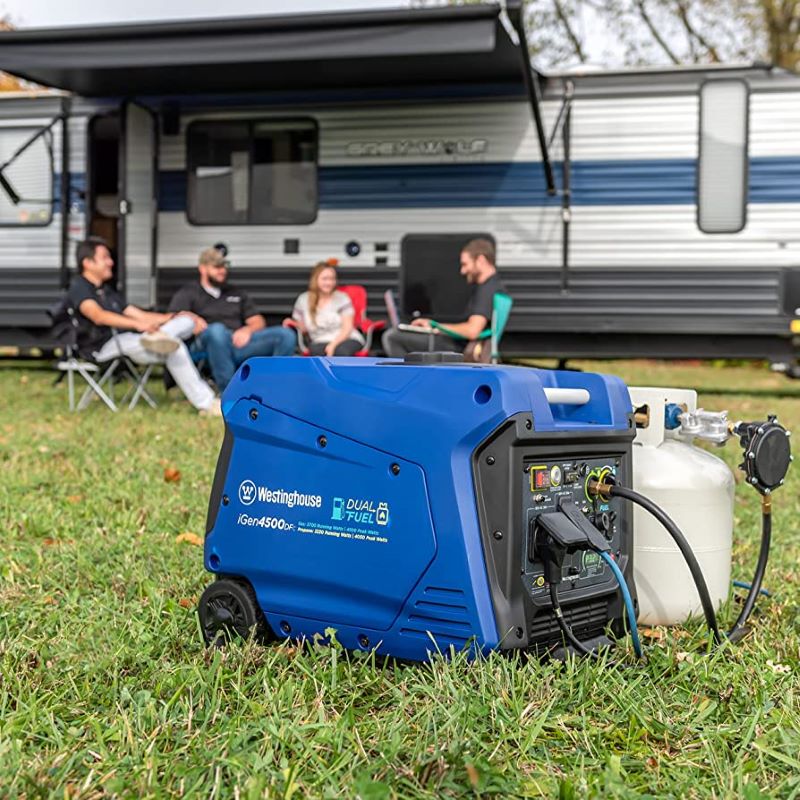
- Fuel Type: Gasoline
- Running Watts: 3,700 watts
- Peak Watts: 4,500 watts
- Run in Parallel: Yes
- Built-In Inverter: Yes
- 30-Amp Plug: Yes
The Westinghouse iGen 4500 comes with just about everything you need in a single generator. Not to mention the fact that it can run in parallel with another iGen 4500 if your power needs are a little more exponential.
It’s a bit on the heavy side at over 90 lbs, but it does have built-in wheels and a telescoping handle for mobility. The 3.4-gallon gas tank provides up to 18 hours of run time at 54 decibels when running the generator in “Economy” mode.
The 54 decibels are lower than a refrigerator and much lower than conversational levels, which are generally at 60 to 70 decibels. Considering the fact that there’s a gas-fed engine in there, that’s pretty incredible. This generator has a remote start which includes a key fob and also a backup recoil start if you just want to crank it like a lawn mower.
As an EPA and CARB-compliant machine, it won’t belch nasty fumes or smoke while it’s running. That doesn’t mean you should run it indoors, it just means that it’s not going to bother the neighbors or you and your family.
The digital displays are always awesome, especially if you’re used to reading those old-school analog displays in older generators. There are a ton of ports available as well, including two 20A, a 120v outlets, a 30A plug, two 5v DC USB ports, and a battery charging port.
The generator also has two parallel port connections for adding a parallel bridge device to run a second iGen 4500 with your first one (50-amp RVs would usually take advantage of this feature).
The rotating digital display provides you with current information, along with warning indicators for things like low oil, the amount of fuel remaining, and how much run time is left before the generator shuts down.
2. Champion 200988 4500-Watt Dual Fuel Inverter Generator
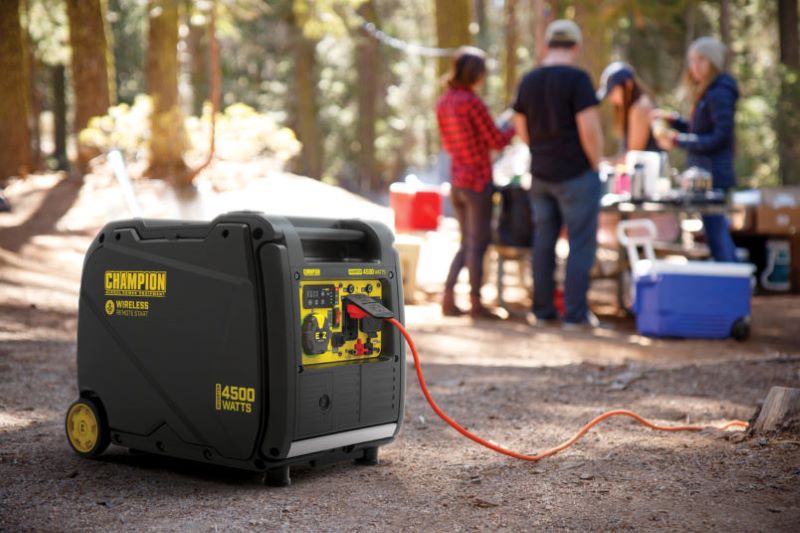
- Fuel Type: Gasoline or propane
- Running Watts: 3,150 watts
- Peak Watts: 4,500 watts
- Run in Parallel: Yes
- Built-In Inverter: Yes
- 30-Amp Plug: Yes
The Champion 200988 4500-Watt is manufactured by Generac, a well-known and warmly welcomed generator manufacturer in both residential homes and RV circles. It takes a shade over half a quart of 10w-30 oil and includes an automated shutdown sensor if your oil is ever low for whatever reason.
When it comes to generators, automated safety trips are lifesavers. If the oil gets low and it keeps running, the motor could be severely damaged. The best feature is the dual-fuel system, which provides RVers with some versatility and potential backup fuel when necessary.
The Champion comes with cold start capabilities, so you won’t have to worry about the generator starting on cold mornings or nights. It has a built-in, automated economy mode that’s part of the inverter. This mode ensures that the current output remains stable and smooth, without sudden peaks or power drop-offs.
It won’t quite give you that full generator for 30-amp RV capability since it’s 450 watts shy of a full 3,600 watts. However, if you need the extra juice, the Champion will run with a second, parallel Champion for double the power pool and capability.
At 61 decibels, it runs at a conversation decibel level, which is a little louder than the Westinghouse but still is very quiet for a gasoline or propane-fueled generator. There are a number of ports available, including parallel ports mentioned, a 30A outlet, two 20A, 120v outlets, an 8A plug, and a 12v DC outlet.
There are three circuits, and all three include quick-button circuit breaker resets. The first circuit holds the 8A 12v outlet. The second circuit is the 20A circuit with house-style outlets. The third circuit is for the single 30A outlet.
3. Honda EU3000i Super Quiet Generator
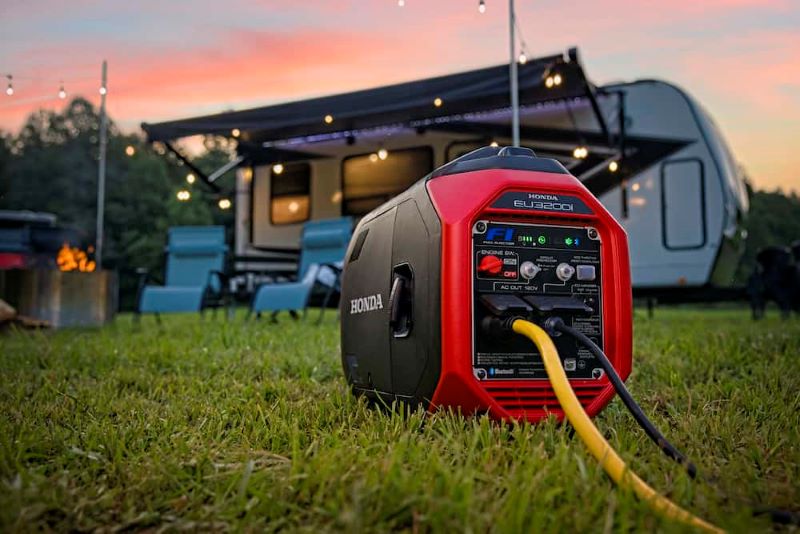
- Fuel Type: Gasoline
- Running Watts: 2,800 watts
- Peak Watts: 3,000 watts
- Run in Parallel: Yes
- Built-In Inverter: Yes
- 30-Amp Plug: Yes
This is one heavy generator at 145 lbs, so prepare yourself for that if you decide to go with the Honda EU3000i. As the name implies, it’s a super-quiet generator, only hitting 57 decibels when running full out. Tone things down a little, and 50 to 51 decibels is more like it.
While it has a 30A plug, it’s 600 watts short of providing you with a full amount of 30 amps of power. However, like the two on the list above, the Honda EU3000i will parallel with a second EU30001. So long as you don’t mind hauling around a total of 290 lbs.
Though it’s a slight step down in terms of power, you still get two circuits, one for the 30A and one for 20A, and120V traditional outlets. The 3.4 gallons of fuel capacity will run the generator for approximately 19 and a half hours, depending on how hard you use it.
As far as your A/C is concerned, the Honda should be more than capable of running yours, though the pool of power resources shrinks considerably after that. The built-in inverter keeps the current flowing smoothly, and you don’t have to worry about plugging in sensitive equipment, such as computers, gaming consoles, and TVs.
The EU3000i is marketed as a generator capable of running a 13,500 BTU A/C unit while still having some space to handle more, like microwaves, a furnace, or a fridge. Unless you are running a parallel setup, it’s probably not a good idea to load all of the above on there at the same time, however.
Despite its heavy weight, the Honda is surprisingly small, so there is a space advantage to owning one. In fact, it’s smaller than the previous two generators to the point where it doesn’t look capable of packing 3,000 watts. Fortunately, it will do just that with room to spare.
4. Generac 7128 GP3500iO 3,500-Watt Gas Generator
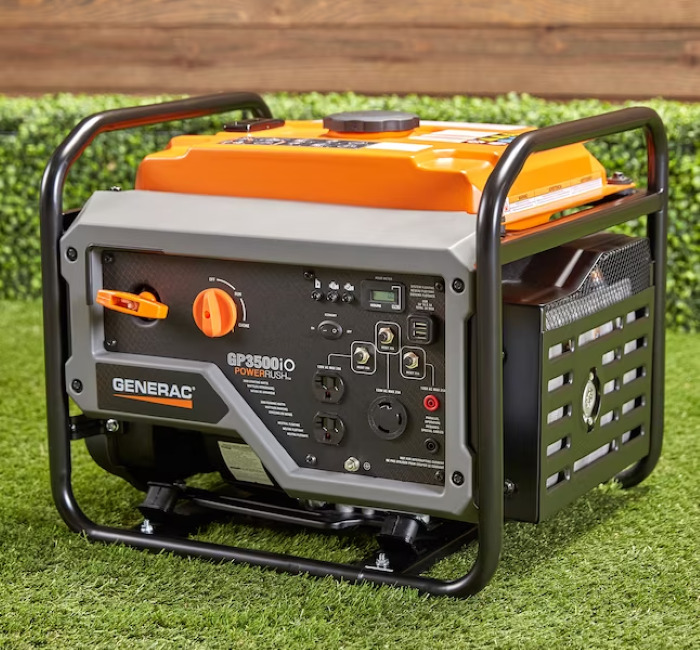
- Fuel Type: Gasoline
- Running Watts: 3,000 watts
- Peak Watts: 3,500 watts
- Run in Parallel: Yes
- Built-In Inverter: Yes
- 30-Amp Plug: Yes
At long last, we arrive at the Generac 7128, 3,500-watt Generator. Generac is known for making outstanding generators, so there is quite a bit of brand association and brand loyalty here. One of the biggest marketing factors of this Generac is the PowerRush capability.
PowerRush is the generator’s ability to deliver a 50% higher power surge in terms of starting capacity. The inverter is designed with Generac’s True Power tech, and it maintains current smooth as butter for those with sensitive electronics or those who just appreciate overall efficiency.
While it weighs half that of the above Honda, it doesn’t come with any wheels or telescoping handles, so it’s a generator that you’ll want to set up and leave there for as long as possible. All of the standard ports you would expect in a good generator are present as well.
There are two 20A/120v traditional outlets, a 30A outlet on a separate circuit, two 8A USB ports, and two ports for tying in parallel wiring for an identical generator. There’s a light for each circuit, and they will illuminate if the breaker is tripped.
There’s also a small digital display that provides you with basic running information and a simple twist knob for start, run, and stop. Since it’s an electric start, the knob is all you need to work with in most cases. But, if you need it, there is also a recoil start option as well.
The Generac 7128 is marketed as a generator capable of running a 15,000 BTU A/C system. Since you combine it with a second 7128, it should take care of all the needs of even the most power-hungry RVs. With two, you’ll have a serious generator for a 30-amp RV.
Final Thoughts On What Size Generator Is Best For 30-Amp RVs
The best size generator for a 30-amp RV will basically range between the above-listed recommendations. It also depends on what your basic needs are. If you live in a cooler climate and prefer to run ceiling fans (much less power draw than an A/C unit), you may not need a 4500.
This is especially true if you have a lot of things running on propane, have solar panels, or have an extensive battery series set up. If you have some power-hungry appliances and you don’t want to do without, a 4500 is a better bet or even a parallel setup with two. The good news is there are a ton of options out there, and now that you know what you need, it’s time to start shopping!
Adding an RV hitch cargo carrier to your travel trailer or RV may be a good idea to store your generator. You could secure the generator onto the cargo carrier with metal wire, chain, or metal generator box. That way, you can run the generator safely on the cargo carrier without moving it, and it’s close to your RV’s shore power wire to plug the RV in.
Related Reading:
– 10 Best Portable and Quiet Generators for Camping
– 5 Best Generator Mounts for a Travel Trailer
– How Often Should I Service My RV Generator?
– Do Travel Trailers Have a Generator?
Mike Scarpignato – Bio
Mike Scarpignato created RVBlogger.com over five years ago in 2018 to share all we have learned about RV camping.
Mike is an avid outdoorsman with decades of experience tent camping and traveling in his 2008 Gulf Stream Conquest Class C RV and 2021 Thor Challenger Class A motorhome.
We attend RV Shows and visit RV dealerships all across the country to tour and review drivable motorhomes and towable trailers to provide the best evaluations of these RVs in our blog articles and YouTube videos.
We are 3/4-time RVers who created RVBlogger.com to provide helpful information about all kinds of RVs and related products, gear, camping memberships, tips, hacks and advice.


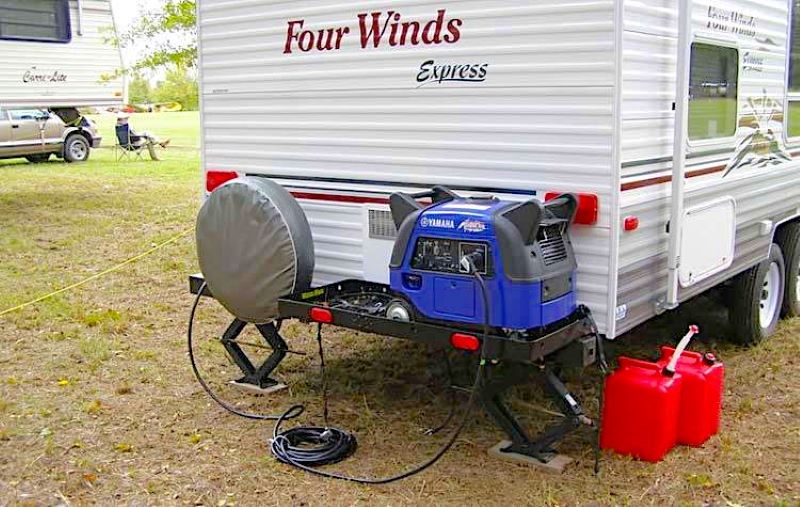
I’m a European and I just don’t use a number of the electric gadgets on your list.
No dishwasher!
No washing machine – launderette or washer/driers at supermarkets.
No electric stove – gas 3 burner hob unit and electric air fryer.
No microwave.
No toaster
No blender – by hand
No gaming console
refrigerator – 600W
Coffee maker (1) electric 1100W/(1) gas hob.
Mini PC 18W/monitor 36W.
Radio via PC
All lighting LED
As my motorhome is diesel why would I want to use anything other than a diesel generator?
OK, I will.
I got two, 3200 that work great but I’ve never paralleled them. If you’re buying one go for the electric start/w blue tooth control. I’m so envious of others, which is wrong.
So I have one that always works and another in case. Even at 3200, I share so I feel I’m getting the best of $4.25 per day. No A/C, fan.